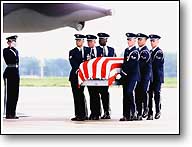Lieutenant Michael Blassie’s long journey home ends today with a hero’s welcome. The combat pilot’s final coordinates: Section 85, Grave No. 1, Jefferson Barracks National Cemetery, south St. Louis County.
Blassie lost his life and, for 26 years, his identity when he was shot down while making a low-level bombing run in South Vietnam on May 11, 1972.
“Killed in action, body not found,” was the official government listing. That changed dramatically in late June when DNA tests confirmed that Blassie’s body was in the Tomb of the Unknowns at Arlington National Cemetery.
His remains are scheduled to arrive late this morning at Scott Air Force Base. Blassie’s remains will be loaded into a hearse. Family members will follow it to the gravesite, under escort from Illinois and Missouri police.
A funeral Mass will be celebrated at 6:30 p.m. at St. Thomas the Apostle Catholic Church, 3500 Rue St. Catherine in Florissant, the parish of Blassie’s mother, Jean F. Blassie.
A graveside service will follow at 10 a.m. Saturday with honors befitting an Air Force pilot killed in action. An honor guard will fire a 21-gun salute, and F-15 Eagle fighters will roar overhead in a “missing man” flyover. The service is open to the public.
“I picked out a nice place for Lt. Blassie,” said Jefferson Barracks superintendent Ralph Church.
Blassie will be laid to rest beneath a blanket of lush bluegrass and fescue in the cemetery’s oldest section, established in 1826 alongside the original military post.
Blassie will get the standard headstone – a simple, 2-foot-high piece of white Georgia marble rounded at the top.
The cemetery doesn’t allow grander markers anymore. The fancy obelisks and granite slabs that mark the graves of some Civil War officers date to the 19th century. The only exception to the current monument-size rule is reserved for the remains of two or more servicemen interred in a common grave.
Dozens of these broad, flat markers break the ranks of the orderly upright stones around Blassie’s site. Many contain the remains of entire World War II bomber crews who perished together.
Blassie will keep courageous company, men shot down over Europe at places that came to be synonymous with death: the Rohr Valley, Schweinfurt and Ploesti.
Ploesti, the heavily defended Nazi oil installations in Romania, is where 1st Lt. Donald D. Pucket, U.S. Army Air Forces, 98th Bombardment Group, crashed in flames. His grave is near Blassie’s.
Pucket had ordered everyone to abandon the damaged B-24 Liberator. But three crew men – either wounded or paralyzed with fear – wouldn’t bail out. So Pucket stayed with them. He was last seen struggling to coax his crippled plane over the mountain where it crashed. He was posthumously awarded the Medal of Honor.
Sgt. Jewett Franklin Adams tops a long list of chiseled names on a gray slab nearby. Adams’ mother may have hoped that the officer who knocked at her door in Cartersville, Ga., bore good news about the son who had been taken prisoner in the early days of World War II.
Instead, he handed her a telegram informing her that Japanese soldiers had killed her son and 122 other American POWs on Palawan Island, Philippines, on Dec. 14, 1944.
Like Blassie, these men had been buried once before.
Their remains were reinterred in this nation’s most centrally located, and second-largest, national cemetery to accommodate their families.
Grounds are prepared
Several dozen groundskeepers – most are Vietnam veterans – keep the 309 acres immaculate. They have fussed over Section 85 all week: trimming grass, blowing away dust, tamping hot asphalt into curbside cracks.
One of the workers, John Levi, waved a wand of bleach mist over the tombstones, which dried bone-white in the sun.
“I often look at their names and wonder what they were thinking in their last moments,” Levi said. “Did it seem like a long time as they fell from the sky? Sometimes I’ll say a prayer.”
As soon as the crowd disperses Saturday morning, Blassie’s grave will be filled and leveled. The site will be seeded.
Every morning, a flag will be raised nearby at the freshly painted Old Flag Pole Circle. It will catch a good breeze off the Mississippi River, which flows beyond a wooded hill.
At the administration building a plaque bears a memorial from Abraham Lincoln for this country’s Michael Blassies. The words are from the Gettysburg Address.
“We can not dedicate – we can not consecrate – we can not hallow this ground. The brave men, living and dead, who struggled here have hallowed it far above our poor power to add or detract.”
Michael Robert Patterson was born in Arlington and is the son of a former officer of the US Army. So it was no wonder that sooner or later his interests drew him to American history and especially to American military history. Many of his articles can be found on renowned portals like the New York Times, Washingtonpost or Wikipedia.
Reviewed by: Michael Howard

